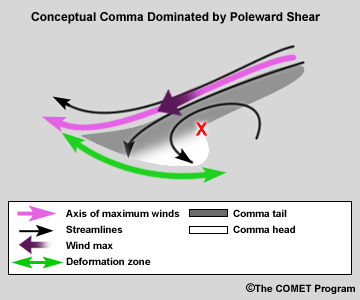Morphology of a Comma Pattern
Roger Weldon originally identified the "comma" cloud pattern in the early 1980's. The cloud and absolute vorticity isopleth correlations he used were empirical. Variation in cloud heights from 500 hPa and time differences between the analysis and the satellite data can lead to errors. However, the centre of cloud rotation as identified by the cusp and the point of inflection is the vorticity maximum.
Comma Dominated by Rotation and/or Equatorial Shear
The inflow arc is associated with the jet axis and defines this type of comma. The portion where you find the maximum of inflow identifies where the jet axis crosses into the moisture area.

The comma head is the portion of the comma downstream from the vorticity maximum. Positive vorticity advection will be strongest in the comma head region as this enhancement is related to the left exit region of the jet.
Comma Dominated by Poleward Shear
The convex arc defines this type of comma. The concave arc region is minimal, and the point of inflection is buried within the moisture area. The comma head is still that portion of the comma downstream from the vorticity maximum.
